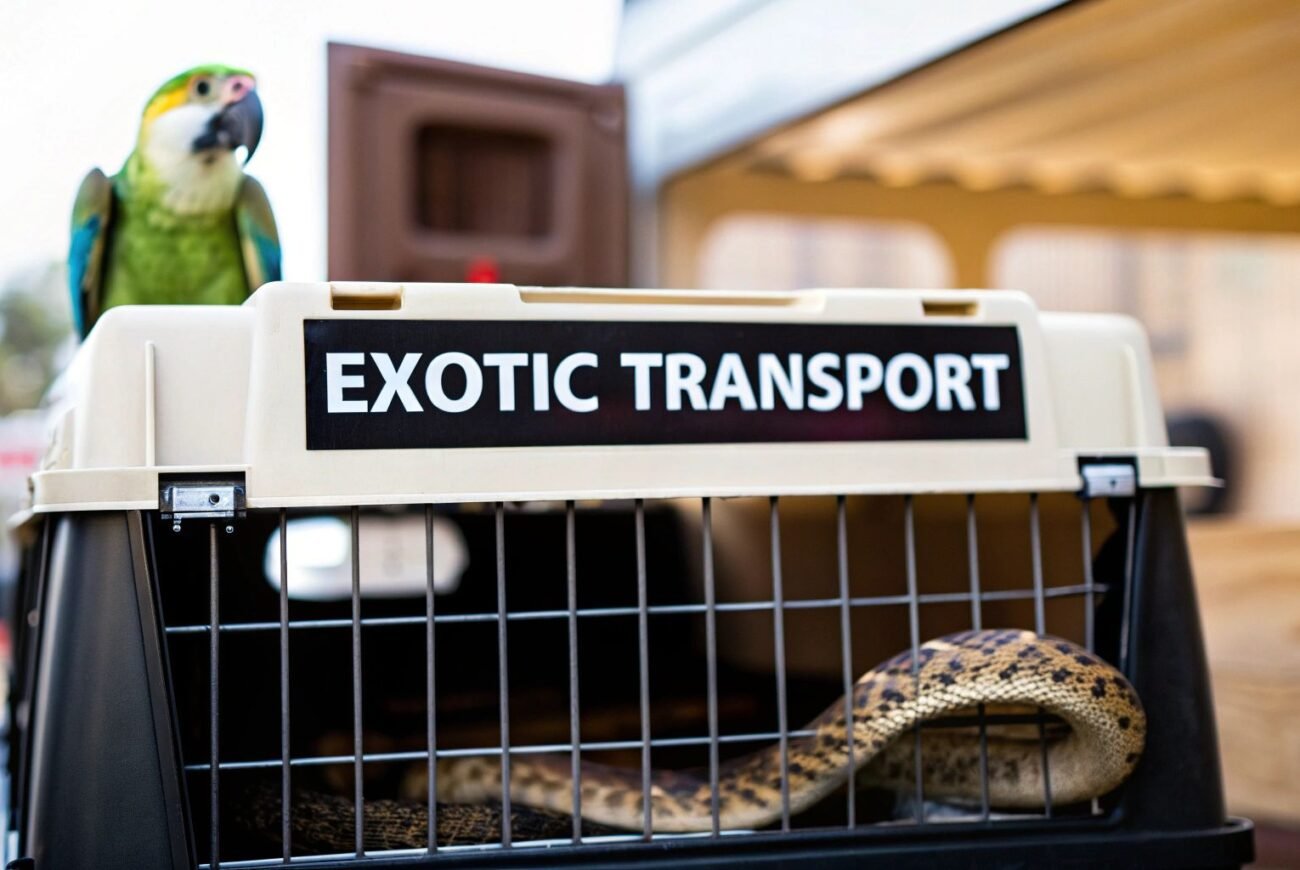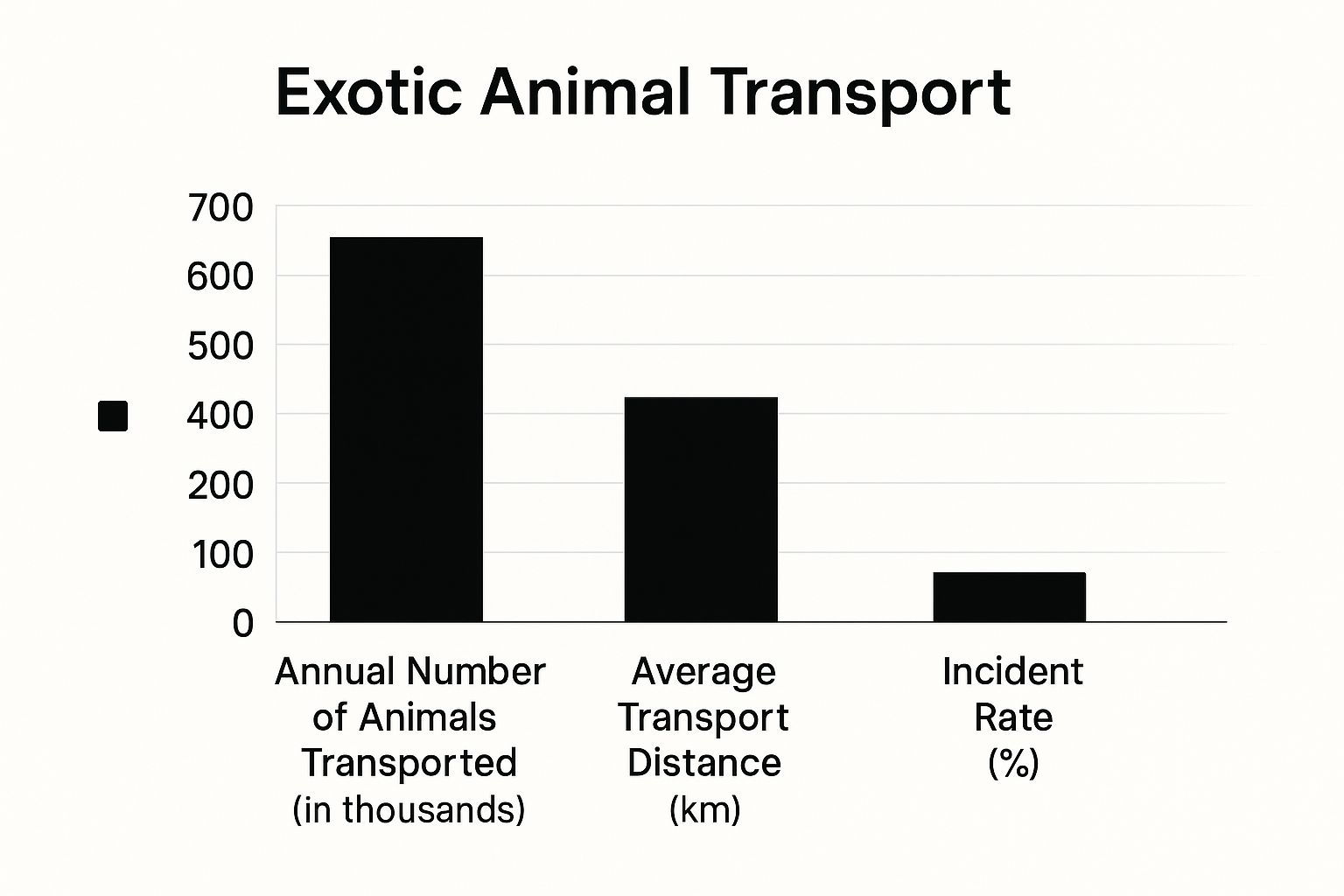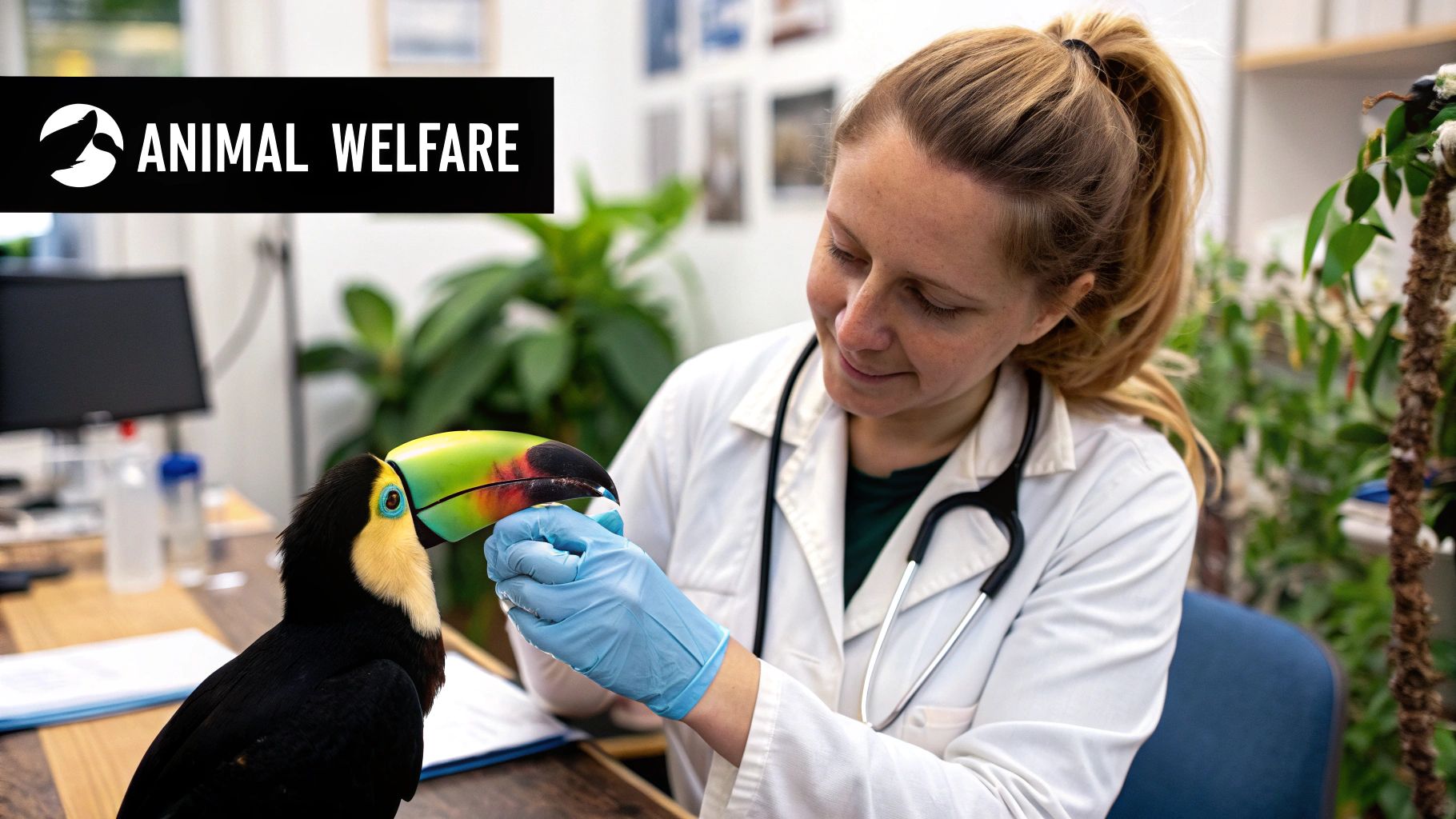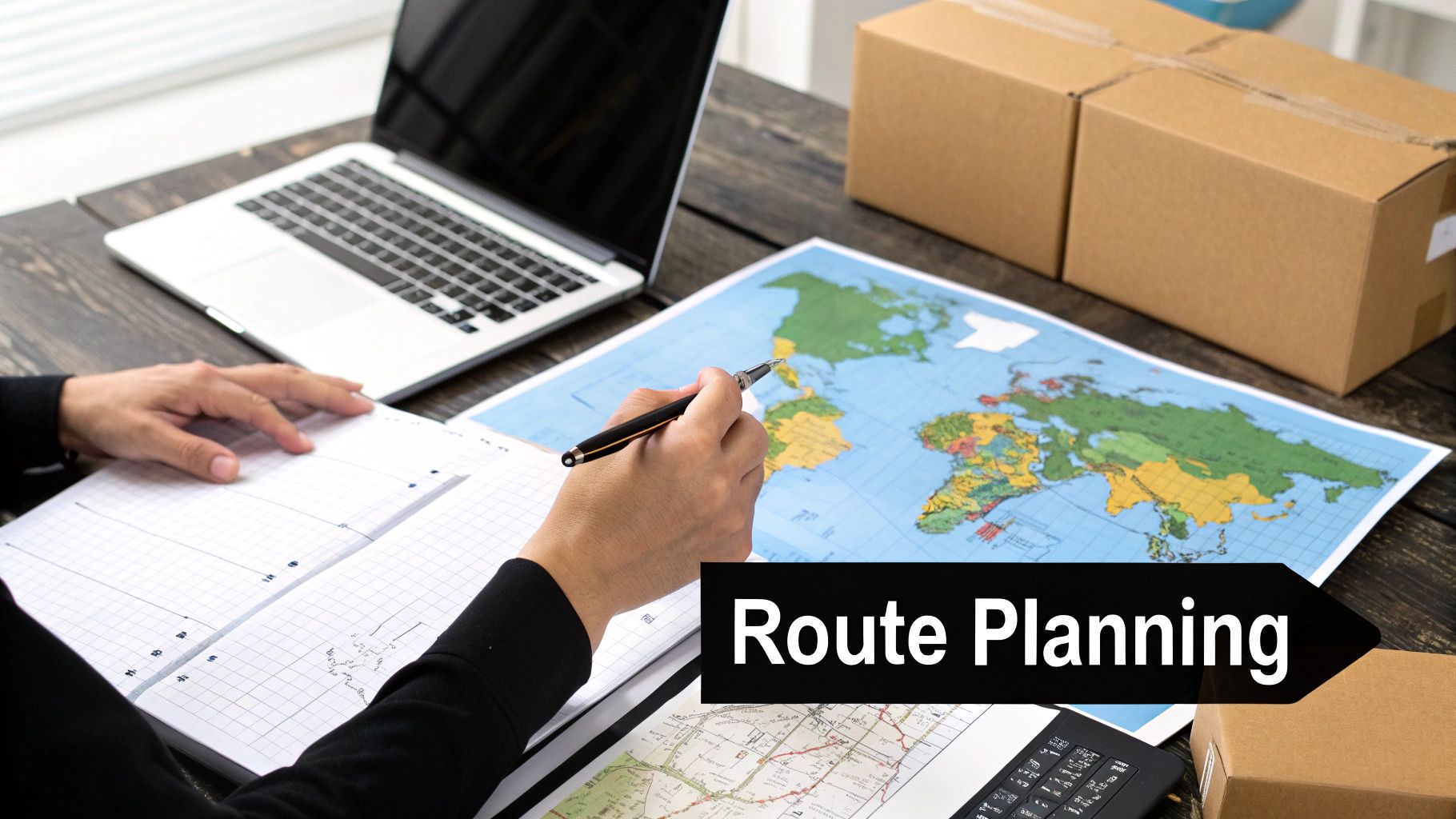
Exotic Animal Transport: Essential Tips for Safe Shipping
Understanding The Exotic Animal Transport Landscape
Exotic animal transport is a complex field, constantly adapting to new challenges and regulations. It involves the specialized relocation of non-domesticated animals, demanding expertise far beyond typical pet shipping. Transporting a parrot, for instance, is significantly different from transporting a dog or cat. Interested in adopting a more unique pet? You might consider Adopting a Capuchin monkey. This niche industry, once handled by a small group of experts, has evolved into a global network, influenced by everything from social media trends to evolving pet ownership preferences.
What Makes Exotic Animal Transport Unique?
Standard pet shipping methods aren't adequate for exotic animals. Their specific requirements necessitate specialized care and handling. Many exotic species, for example, need precise temperature and humidity regulation during transport to avoid illness or even death.
Their dietary needs also often differ significantly from common pets. This requires specialized food preparation and specific feeding schedules throughout the journey. These unique needs drive the demand for skilled transporters with a deep understanding of these animals' care.
The following infographic illustrates key metrics in exotic animal transport: annual number of animals transported, average transport distance, and incident rate. These figures highlight the scale and inherent risks within this expanding field.

As the infographic shows, a considerable number of animals are transported annually, with distances often covering thousands of kilometers. This emphasizes the critical need to minimize incidents through meticulous planning and execution. This increasing demand mirrors broader trends in the pet market. The global pet travel and transport market continues to expand. The pet travel services market reached $2.3 billion in 2024 and is projected to hit $4.3 billion by 2033, a CAGR of almost 7%. North America currently dominates, holding over 38.9% of the market share in 2024.
The table below provides a regional breakdown of the exotic animal transport market. It showcases the market share and growth projections across different regions, highlighting key species transported in each area.
| Region | Market Share (%) | Growth Rate | Key Species |
|---|---|---|---|
| North America | 38.9 | 7.5% | Reptiles, Primates, Birds |
| Europe | 25.2 | 5.8% | Birds, Reptiles, Fish |
| Asia-Pacific | 18.5 | 9.2% | Fish, Birds, Invertebrates |
| South America | 10.3 | 6.1% | Reptiles, Amphibians, Birds |
| Africa | 7.1 | 4.5% | Reptiles, Birds, Mammals |
This data underscores the global nature of exotic animal transport and the varying growth rates across different regions. The Asia-Pacific region, for example, is experiencing the fastest growth, driven by increasing demand for exotic pets and a growing awareness of conservation efforts.
Key Players and Geographic Hotspots
Several key players shape the exotic animal transport industry, from specialized transport companies and breeders to zoos and conservation organizations. However, the industry faces growing scrutiny. Public awareness surrounding ethical concerns and animal welfare is rising. This means transporters must prioritize transparency and adhere to the highest standards of care. Certain geographic locations become hubs for exotic animal movement, often reflecting areas with high demand or specific regulations. These factors contribute to the dynamic and often complex nature of exotic animal transport.
Navigating Legal Requirements That Actually Matter
Exotic animal transport regulations are intricate and ever-changing, a critical concern for anyone involved in this field. Grasping these regulations isn't simply a legal obligation; it's a moral one, essential for the animals' welfare. These laws exist to shield animals from harm during transport and prevent disease outbreaks.
CITES Permits and Import/Export Documentation
A cornerstone of legal exotic animal transport is the Convention on International Trade in Endangered Species of Wild Fauna and Flora (CITES). CITES permits are vital for legally transporting many exotic species across international borders. These permits ensure the trade doesn't endanger these species' survival in the wild.
Furthermore, individual countries mandate specific import and export documentation, often differing based on the species and transport purpose. These documents may include health certificates, origin certificates, and permits from relevant agricultural or wildlife agencies. For details on U.S. transport regulations, check out our guide on exotic pet laws by state.
Health Certifications and Species-Specific Regulations
Exotic animals typically need health certifications from a qualified veterinarian before transport. These certifications confirm the animal is disease-free and fit to travel. Certain species may face additional regulations due to their conservation status or potential to become invasive.
For instance, transporting endangered species may require extra permits and stricter adherence to specific transport protocols. This could involve specialized containers, specific routes, and strict timelines to minimize animal stress.
Over 20 years, 1,356 different wild-caught species were imported into the U.S., revealing the scale and diversity of the exotic animal trade. Tragically, roughly 80% of illegally traded animals die during transit or within a year of captivity. This emphasizes the need for improved standards and oversight in exotic animal transport. Learn more here. Non-compliance penalties can range from significant fines and animal confiscation to prosecution.
Staying Ahead of Changing Regulations and Building Relationships
Staying informed about evolving exotic animal transport regulations is crucial. Laws are updated frequently, and claiming ignorance isn't a defense. Subscribing to relevant newsletters, attending industry conferences, and consulting legal professionals can help maintain compliance. Cultivating strong relationships with regulatory officials is also invaluable. Open communication and a proactive compliance approach can simplify approvals and prevent potential problems. You might find this helpful: How to master exotic animal transport.
This proactive stance benefits the animals and protects your business or organization from the severe consequences of regulatory violations. By prioritizing both the technicalities and the intent of these laws, we can ensure humane and responsible exotic animal transport worldwide.
Safety Protocols That Keep Animals Alive And Thriving
Transporting exotic animals is a complex undertaking. It's not simply about moving them from one location to another; it's about ensuring their safety and well-being during the entire process. This requires a deep understanding of each species' unique needs, going far beyond basic safety precautions. For example, reptiles are particularly vulnerable to temperature changes, which can quickly become life-threatening.

Understanding Species-Specific Needs
Different species react to stress in different ways. Birds, for instance, handle stress differently than mammals. Handling techniques appropriate for one might be harmful to another. This knowledge is crucial for safe and humane exotic animal transport. Professional transporters must be skilled in recognizing signs of distress and adapting their methods accordingly. For more information on primate care, check out this article on how long pet monkeys live.
Pre-Transport Health Assessments and Emergency Response
A comprehensive health check by a veterinarian before transport is essential. This confirms the animal is fit to travel and helps identify potential health concerns that might arise during the journey.
Having solid emergency procedures in place is also critical. These procedures should address unforeseen circumstances like travel delays, equipment problems, or unexpected health issues. Effective emergency protocols must be well-practiced and tailored to the specific species being transported.
Container Design Principles: Balancing Compliance and Comfort
Transport containers must meet regulations while prioritizing the animal's comfort. Adequate ventilation is key for preventing suffocation and managing odors. Secure closures are crucial for the animal's safety and prevent escapes.
The container size needs to allow the animal to move naturally. This reduces stress and helps prevent injury. A confined space can cause significant stress, particularly for birds, potentially affecting their respiratory health.
Monitoring Vital Signs, Feeding, and Hydration
Throughout the journey, professionals monitor vital signs. This includes heart rate, respiratory rate, and body temperature. Maintaining hydration is crucial, especially for species prone to dehydration, such as reptiles.
Feeding schedules should align with the animal's natural eating patterns and dietary requirements. Some animals may need specialized feeding equipment or specific food types during transport.
Species-Specific Care and Stress Reduction
Detailed checklists for species-specific care are invaluable tools. These checklists help ensure all essential needs are addressed, from temperature control to environmental enrichment. Effective stress-reduction techniques are equally important. Minimizing noise and vibrations can greatly reduce stress in many exotic animals. Providing familiar objects or scents can create a sense of security. This focus on detail sets apart true professionals in exotic animal transport.
Equipment And Technology That Makes Transport Possible
Standard pet carriers simply aren't designed for the intricate requirements of exotic animal transport. Specialized equipment is absolutely essential to guarantee the safety and well-being of these unique creatures during relocation. It's this specialized equipment that truly sets professional exotic animal transport apart from risky amateur attempts.

Climate Control and Ventilation
Maintaining precise temperature and humidity levels is crucial for the survival of many exotic species. Climate control systems, often integrated directly into transport vehicles, are the key to regulating these factors. Reptiles, for example, are especially sensitive to temperature fluctuations, making a consistent environment absolutely critical during transport.
Proper ventilation also plays a vital role. It prevents suffocation, controls odors, and ensures a healthy atmosphere within the transport container. Many advanced systems even utilize filtration to minimize the spread of airborne pathogens.
Monitoring Technology and Emergency Backup Systems
Real-time health data monitoring is becoming increasingly important in the world of exotic animal transport. Sensors placed within the containers track vital signs like heart rate and body temperature, immediately alerting transporters to any potential problems. This allows for rapid intervention if an animal shows signs of distress.
Beyond immediate health monitoring, this technology also records important environmental data. This information provides valuable insights that can improve future transports. Emergency backup systems are another critical component. Redundant power supplies, backup ventilation, and alternative transport plans are all essential for mitigating risks should primary equipment fail. These backups ensure the animals remain safe, even in unforeseen circumstances.
Specialized Transport Vehicles and Tracking Systems
Transport vehicles are often modified to cater to the specific needs of different species. Modifications can include custom-built compartments, specialized restraints, and dedicated climate-controlled zones within the vehicle itself. Primates, for instance, might require secure enclosures with climbing structures to minimize stress, while aquatic animals need specialized tanks with filtration and oxygenation systems.
GPS tracking systems provide real-time location updates, enhancing security and allowing for proactive adjustments to the transport route as needed. This technology allows for precise monitoring throughout the entire journey, facilitating faster response times in emergencies.
Innovations in Container Design, Remote Monitoring, and Communication
Container design is a constantly evolving field. New materials and innovative designs are continually improving insulation, ventilation, and overall security. Some containers now incorporate remote monitoring capabilities, transmitting data wirelessly to transporters. This allows for continuous assessment of the animal's condition and the container environment, even from a distance.
Improved communication systems are also making a significant impact. These systems keep all stakeholders informed with real-time updates on the animal's status, location, and estimated arrival time. These advancements in technology and equipment are making the transport of exotic animals safer and more efficient than ever before.
How Social Media Changed Everything About Exotic Pets
Social media has undeniably impacted exotic pet ownership. Platforms like Instagram and TikTok frequently showcase these animals, often in idealized settings. This increased exposure has fueled a surge in demand, significantly changing the exotic animal transport industry. This visibility presents both opportunities and challenges.
The Rise of Exotic Pet Influencers
Influencers showcasing exotic pets have played a crucial role in this trend. Their posts often reach massive audiences, normalizing exotic pet ownership and driving up demand. This, in turn, pressures transport services to meet this growing need. Social media has significantly popularized exotic pet ownership and, as a result, exotic animal transport. For example, one pet fox became a social media sensation, gaining over 2 million followers on TikTok since 2018. Views for exotic animals like bush babies increased by 472% in a 2022 study. More detailed statistics can be found here. This popularity surge directly translates into increased demand for exotic animal transportation.

Geographic Hotspots and Adapting Transport Services
Social media trends also influence which geographic locations experience the largest increases in exotic pet interest. Transport companies are adapting their services to match, expanding their routes and developing specialized handling protocols for different species. Some companies are even using social media for marketing, connecting directly with potential clients.
Increased Scrutiny and Higher Standards
Increased visibility also brings more scrutiny. Animal welfare organizations and the public are now more aware of the potential risks of exotic animal transport. This has led to calls for higher standards and stricter regulations, meaning transport providers must prioritize ethical practices and transparency to maintain their credibility.
Emerging Market Trends: From Micro-Exotics to Mainstream Rare Species
Social media also influences the types of exotic pets in demand. Micro-exotic pets, like certain reptiles and amphibians, are gaining popularity due to their perceived ease of care. At the same time, some rare species are becoming more mainstream, adding further complexity to transport logistics and regulatory compliance. Transport providers must stay abreast of these changing trends to anticipate demand and adapt their services.
Consumer Expectations vs. The Reality of Responsible Transport
Social media often presents a simplified view of exotic pet ownership. This can create unrealistic expectations among consumers regarding the complexities of transport. Responsible transport involves far more than simply moving an animal from one location to another. It requires meticulous planning, specialized equipment, and a deep understanding of each species' unique needs. Bridging the gap between consumer perception and the reality of ethical exotic animal transport remains a crucial challenge for the industry.
Choosing Transport Services That Won't Let You Down
Finding reliable exotic animal transport can be challenging. Not every service provider prioritizes animal welfare and safety equally. Thorough research is essential to identify genuine professionals dedicated to providing the best possible care during transport.
Key Credentials and Questions to Ask
When selecting a transport service, certain credentials are non-negotiable. Licensing and permits must be current and valid. Verify the company's insurance coverage, ensuring it aligns with the specific species being transported. For instance, the requirements for a venomous snake differ significantly from those for a bird. Asking detailed questions about the company's experience is also crucial.
Do they have a proven track record with the specific species you need transported? A company specializing in reptiles may lack the necessary expertise for primates. Inquire about their emergency protocols. A well-defined plan demonstrates preparedness for unexpected events. Open communication is another key indicator of a reputable service. The company should readily offer information and regular updates throughout the transport process.
Red Flags to Watch Out For
Evasive answers are a major warning sign. If a company hesitates to provide details or address your concerns, proceed with caution. Lack of species-specific expertise is another significant concern. Exotic animals have unique needs, and experience handling a particular species is vital for their well-being. Be wary of unusually low prices. Significantly discounted rates may indicate cost-cutting measures that could compromise animal safety and care.
Verifying Insurance and Assessing Facilities
Don't just take a company's word regarding insurance. Independently verify the policy details with the insurance provider. This confirms both the policy's validity and its coverage limits. Evaluate the company's facilities. Are the areas clean, secure, and properly equipped to handle the animals they transport? Assess their emergency response capabilities. Do they have established procedures and access to emergency veterinary care along transport routes?
Staff Training and Species-Specific Experience
The expertise of the staff handling the animals is paramount. Inquire about their training and experience, specifically with your animal's species. Different animals have unique requirements. For example, some reptiles need precise temperature control, while birds may be more susceptible to stress. This specialized knowledge is essential for preventing injury and minimizing discomfort during transport.
Transparent Communication Throughout the Transport
Clear and consistent communication is a hallmark of professional exotic animal transport. The company should proactively provide updates on the animal's status and location. They should also be readily available to address your questions. This open communication fosters trust and reduces anxiety for everyone involved.
Evaluation Checklist and Contract Terms
Choosing the right transport provider significantly impacts your exotic animal's well-being. Careful evaluation increases the chances of a safe and smooth transport experience. The following checklist can assist in your assessment.
To help you evaluate potential transport services, we've compiled a comprehensive checklist:
| Criteria | Essential Requirements | Additional Benefits | Red Flags |
|---|---|---|---|
| Licensing & Permits | Valid and up-to-date permits | Membership in professional organizations | Lack of proper documentation |
| Insurance | Adequate coverage for the species | Specialized coverage for emergencies | Unwillingness to disclose insurance details |
| Experience | Proven experience with your specific species | Testimonials and references | Evasive answers to experience questions |
| Facilities | Clean, secure, and appropriately equipped | Climate-controlled areas, separate species holding | Unclean or inadequate facilities |
| Emergency Response | Clear protocols and access to vet care | 24/7 emergency contact | Lack of a clear emergency plan |
| Staff Training | Trained in species-specific handling | Certified animal handlers | Inexperienced or untrained staff |
| Communication | Proactive updates and responsive | Dedicated communication channels | Unresponsive or difficult to reach |
| Contract Terms | Clear terms, including liability | Customized transport plans | Vague or unfair contract terms |
This checklist highlights key criteria to consider, from essential requirements to potential red flags. Using this framework will help ensure you select a provider committed to safe and humane animal transport.
Thoroughly review the transport contract. Ensure it clearly defines responsibilities, liabilities, and contingencies. Important details to look for include specified transport methods, timelines, and costs. Pay close attention to clauses addressing cancellations, delays, and emergencies. A well-defined contract safeguards both you and the animal.
Real Costs And Smart Planning For Transport Success
Exotic animal transport represents a significant financial commitment. Understanding the factors influencing pricing is crucial for effective planning and avoiding unexpected costs. This knowledge allows you to make informed decisions and budget appropriately.
Decoding The Cost Structure Of Exotic Animal Transport
Transport fees themselves are only one part of the equation. Specialized equipment, regulatory compliance, and insurance significantly contribute to the total cost. For example, transporting a venomous snake necessitates specialized containers and careful handling, increasing the overall expense. Distance also plays a key role. Longer distances lead to higher fuel costs, extended travel times, and potentially more intricate logistics. The complexity of the species is another important consideration. The specialized care a reptile requires during transport, such as temperature regulation, differs significantly from a mammal's needs, impacting overall costs.
Additionally, the specialized market for animal transport is poised for substantial growth. Valued at $0.74 billion in 2025, it is projected to reach $1.16 billion by 2030, exhibiting a CAGR of 9.24%. More detailed statistics can be found here. This growth highlights the increasing demand and specialized nature of this service.
Hidden Costs And Contingency Planning
Beyond the readily apparent expenses, hidden costs can easily arise. Quarantine facility fees can be substantial, especially for international transports. Similarly, the possibility of needing emergency veterinary care en route adds another layer of financial complexity. Planning for contingencies is crucial. Unexpected delays, route changes, or unforeseen health issues can all influence the final price. Establishing a financial buffer safeguards against these potential issues.
Cost Optimization Strategies Without Compromising Welfare
Optimizing costs should never compromise animal welfare. Selecting the cheapest option can have dire consequences. Cutting corners on essential equipment or neglecting necessary veterinary care jeopardizes the animal's health and safety. True cost optimization involves finding a balance between affordability and ethical considerations. For instance, transporting multiple animals together, when appropriate and safe, can reduce per-animal costs.
The Importance Of Insurance And The Value Of Quality
Insurance is a non-negotiable aspect of exotic animal transport. It protects against financial losses arising from unexpected events, from accidents to health issues. Neglecting insurance can expose you to significant financial risk if something goes wrong. While cost is a factor, prioritizing quality service over price is essential. Choosing a reputable transporter with proven experience and a commitment to animal welfare represents a valuable investment in the animal's safety and your peace of mind.
Planning Tools And The Timing Of Transport
Using practical planning tools, such as transport cost calculators and species-specific care checklists, can streamline the planning process. These resources empower informed decisions and ensure you are prepared for every aspect of the transport. Sometimes, postponing transport is the most financially prudent decision. Seasonal demand can greatly affect pricing. Transporting an animal during peak seasons can increase costs due to higher demand and limited availability. Flexibility with transport dates can sometimes lead to significant savings.
Ready to provide your exotic companion with safe and reliable transport? Visit Primate Pets to learn how our specialized services prioritize your animal's well-being throughout the entire process. We manage all the logistics, ensuring a smooth and stress-free transport experience for both you and your beloved pet.





Comments
Exotic Pet Laws by State: Know the Key Regulations - primatepet.com
July 7, 2025[…] regulatory frameworks in the United States. This system aims to balance the desire for exotic pet ownership with public safety and animal welfare. Florida categorizes animals into a three-tiered […]